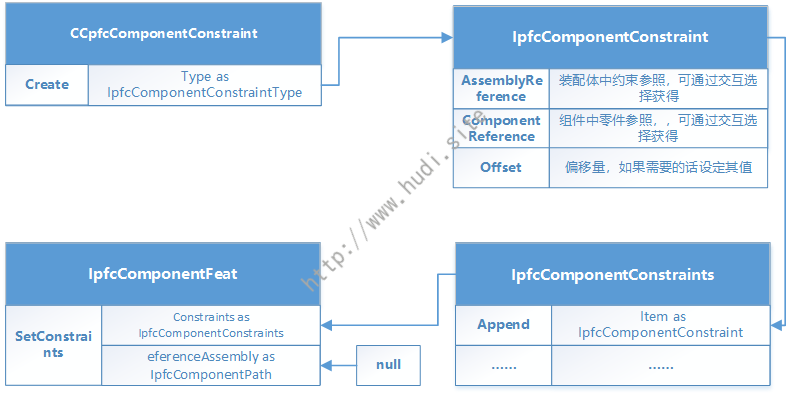本节介绍VBAPI如何向装配体中插入组件并添加约束。整个装配体由IpfcAssembly类进行描述,其父类为IpfcSolid类。IpfcAssembly类提供了AssembleComponent等方法完成组件的装配等操作。至于装配体中的组件,VBAPI使用IpfcComponentPath类描述其装配树信息,提供了如ComponentIds、GetTransform等属性或方法描述在装配树中的ID及获取位姿矩阵等;提供IpfcComponentFeat描述各组件的相关特征信息,通过CompType、GetConstraints等属性或方法获得或修改其相关特性,其父类为IpfcFeature。组件间的约束由IpfcComponentConstraint类进行描述。
在进行Creo的装配体二次开发前必须对装配树和位姿矩阵等内容进行了解,在很多toolkit的介绍书籍以及vbapi手册已有了详细介绍,在此不再对这些概念进行展开。
1. 插入一个零件 向当前装配体插入一个组件由IpfcAssembly的AssembleComponent方法完成。IpfcAssembly为IpfcSolid的子类(IpfcSolid为IpfcModel的子类),表示一个装配体。AssembleComponent方法有两个参数,第一个参数Model为IpfcSolid类。Model可以是一个零件也可以是一个装配体,可以通过Session的RetrievemodelWithOpts方法加载,通过文件路径打开返回IpfcSolid的方法已在前文介绍过,在此不在重复说明。第二个参数Position为IpfcTransform3D类。IpfcTransform3D类为包含了坐标系统转换的信息,提供诸如GetOrigin、GetXAxis等方法获取相关信息。IpfcTransform3D由CCpfcTransform3D.Create方法生成。CCpfcTransform3D.Create有一个可选参数Matrix为IpfcMatrix3D类,对应生成后的IpfcTransform3D的属性Matrix。IpfcMatrix3D类用一个4X4的二维数组位姿矩阵信息,同时提供了如Item、Set等方法获取或设定位姿矩阵信息。向装配体插入一个零件如图6-1所示,示例代码如下:
1 2 3 4 5 6 7 8 9 10 11 12 13 14 15 16 17 18 19 20 21 22 23 24 25 26 27 28 29 30 31 32 33 Dim model As IpfcModelDim assembly As IpfcAssemblyDim modelDesc As IpfcModelDescriptorDim componentModel As IpfcSolidDim fileOpenopts As IpfcFileOpenOptionsDim filename As String Dim retrieveModelOptions As IpfcRetrieveModelOptionsDim matrix As New CpfcMatrix3DDim transform3D As IpfcTransform3Dmodel = asyncConnection.Session.CurrentModel fileOpenopts = (New CCpfcFileOpenOptions).Create("*.prt" ) filename = asyncConnection.Session.UIOpenFile(fileOpenopts) modelDesc = (New CCpfcModelDescriptor).Create(EpfcModelType.EpfcMDL_PART, Nothing , Nothing ) modelDesc.Path = filename retrieveModelOptions = (New CCpfcRetrieveModelOptions).Create retrieveModelOptions.AskUserAboutReps = False componentModel = asyncConnection.Session.RetrievemodelWithOpts(modelDesc, retrieveModelOptions) assembly = CType(model, IpfcAssembly)For i = 0 To 3 For j = 0 To 3 If i = j Then matrix.Set (i, j, 1.0 ) Else matrix.Set (i, j, 0.0 ) End If Next Next transform3D = (New CCpfcTransform3D).Create(matrix) assembly .AssembleComponent(componentModel, transform3D)
图6-1 插入一个零件流程
2. 零件的删除和隐含 在Creo中,零件可以认为是装配体的一个特征,故零件的删除和隐含等操作与特征的删除和隐含相同,在第五节已介绍,在此不再赘述。
3. 设置约束 VBAPI提供了IpfcComponentFeat类描述装配体中的组件(零件或子装配体)。IpfcComponentFeat类继承自IpfcFeature类,提供了SetConstraints方法设定零件的约束。SetConstraints方法有两个参数,第一个Constraints为IpfcComponentConstraints类型,为IpfcComponentConstraint表示一个IpfcComponentConstraint类型的序列。第二个参数ReferenceAssembly为IpfcComponentPath类型,表述零件约束的参考装配体。一般如果约束仅应用于本装配体组件, 则此参数的值设为null。如果约束针对装配体中某一子装配体中的某一个零件,则此参数为针对零件的IpfcComponentPath。本例中我们默认约束仅针对于本装配体组件,设为null。IpfcComponentConstraint类表示一个约束,由CCpfcComponentConstraint.Create方法生成。CCpfcComponentConstraint.Create方法的参数Type为IpfcComponentConstraintType类,表示约束的类型,是一个枚举类。IpfcComponentConstraint另外还有ComponentReference和AssemblyReference两个重要属性,其均为IpfcSelection类,可通过前文所述的选择对象方法获取,分别表述该组件和装配体中的约束参照。如果IpfcComponentConstraintType为EpfcASM_CONSTRAINT_MATE_OFF等类型,还需设定约束的值Offset(Double类型)。向装配体中一个组件设置约束如图6-2所示,示例代码如下:
1 2 3 4 5 6 7 8 9 10 11 12 13 14 15 16 17 18 19 20 21 22 23 24 25 26 27 28 29 30 31 32 33 34 35 36 37 38 39 40 41 42 43 44 45 46 47 48 Dim selectionOptions As IpfcSelectionOptionsDim selections As CpfcSelectionsDim selectFeats As IpfcSelectionDim selectedComponent As IpfcModelItemDim componentFeat As IpfcComponentFeatDim compConstraints As New CpfcComponentConstraintsDim compConstraint As IpfcComponentConstraintDim asmReference As IpfcSelectionDim compReference As IpfcSelectionDim offset As Double = 100 selectionOptions = (New CCpfcSelectionOptions).Create("component" ) selectionOptions.MaxNumSels = 1 selections = asyncConnection.Session.Select (selectionOptions, Nothing ) If selections.Count > 0 Then selectFeats = selections.Item(0 ) selectedComponent = selectFeats.SelItem componentFeat = CType(selectedComponent, IpfcComponentFeat) selectionOptions = (New CCpfcSelectionOptions).Create("surface" ) selectionOptions.MaxNumSels = 1 selections = asyncConnection.Session.Select (selectionOptions, Nothing ) If selections.Count > 0 Then asmReference = selections.Item(0 ) Else MessageBox.Show("请选择装配体中其余零件的表面!" ) End If selectionOptions = (New CCpfcSelectionOptions).Create("surface" ) selectionOptions.MaxNumSels = 1 selections = asyncConnection.Session.Select (selectionOptions, Nothing ) If selections.Count > 0 Then compReference = selections.Item(0 ) Else MessageBox.Show("请选择当前零件的表面!" ) End If compConstraint = (New CCpfcComponentConstraint).Create(EpfcComponentConstraintType.EpfcASM_CONSTRAINT_MATE_OFF) compConstraint.AssemblyReference = asmReference compConstraint.ComponentReference = compReference compConstraint.Offset = offset compConstraints.Append(compConstraint) componentFeat.SetConstraints(compConstraints, Nothing ) End If
图6-2 设置约束流程
完整代码可在Github.com 下载。

